Thousands left homeless by Indonesia's earthquake have awoken after spending
a second night without shelter as rescuers dug desperately for anyone still
trapped in the rubble.

A woman feeds her
injured husband inside a tent outside of a hospital during a rainfall in
Bantul, Yogyakarta province of Central Java. Rescue workers dug
desperately through rubble for survivors of Indonesia's earthquake as
weeping relatives buried victims of the disaster.
[AFP] |
With the death toll close to 5,000, troops and emergency rescue teams joined
volunteers who clawed at debris with their bare hands after Saturday's quake in
Central Java, but power blackouts and heavy rain hampered their efforts.
In Bantul district south of the provincial capital Yogyakarta, the stench of
bodies filled the air as soldiers used a backhoe to dig through the rubble in
one neighbourhood that had been completely levelled.
The top priority was to "evacuate victims still trapped in the rubble, using
heavy equipment," said Gendut, a provincial health official.
Residents said at least two people remained trapped.
Yuni, a woman in her 40s, searched frantically for her uncle whose house had
collapsed.
"We are resigned and willing to let him go. Our only hope is that we can find
his body so we can bury him properly," she told AFP.
Bodies were still being pulled from the wreckage of homes as grieving
families buried their dead in makeshift graves.
Indonesia appealed for foreign aid, with Foreign Minister Hassan Wirayuda
saying in Malaysia: "This is a humanitarian disaster. Any country that can
contribute, we are grateful for it."
Hospitals struggled to cope with thousands of injured, many of whom spent the
night outside, while relief workers took food and medical supplies to some of
the 200,000 people left homeless.
The lack of shelter, combined with heavy rain, set the stage for a grim
second night undercover, with groups of people huddled under tarpaulins to stay
dry.
The International Federation of Red Cross and Red Crescent Societies issued
an emergency appeal for nearly 10 million dollars and separate multi-million
dollar aid pledges poured in from overseas.
Aid workers said the priority was to treat the injured, but warned that
dwindling supplies and a lack of housing could pose long-term challenges.
"Clearly the top priority right now is the treatment of injured people,"
UNICEF spokesman John Budd told AFP.
"There are three hospitals in Bantul and five in Yogyakarta -- all are
overwhelmed and they are not even treating the slightly injured any more," he
said.
Anton Susanto, a member of the UNICEF team already in the quake zone, said 30
to 40 percent of those injured were children, with many suffering from head
wounds and broken bones.
"People are just laid out everywhere," he said.
"People are still very, very traumatised. Frequent aftershocks are still
going on."
More than 470 aftershocks have terrified residents already afraid to return
home.
Adding to the fear, Mount Merapi -- a volcano north of the quake's epicenter
-- continued to simmer after weeks of seismic activity that saw 20,000 people
evacuated from their homes amid a major eruption alert.
Most of the damage and casualties occurred in the lush green farming belt
south of the ancient city of Yogyakarta.
Susanto said survivors were streaming into the city from worse-affected areas
in search of aid and shelter.
As volunteers distributed food, bottled water, tents, tarpaulins and baby
kits, troops battled to repair cracks in Yogyakarta's airport runway to speed
the arrival of aid shipments.
The French foreign ministry said a 40-person rescue team is to leave late
Sunday for Java. Spain also said it will send relief supplies on Monday.
Japan, Malaysia, Singapore, Taiwan and Turkey have all dispatched emergency
medical teams.
The quake was Indonesia's third major disaster in 18 months, following the
2004 Asian tsunami catastrophe that killed 168,000 in Sumatra and another quake
that killed more than 600 people in Nias in March last year.
The Jakarta government has earmarked 50 billion rupiah (5.5 million dollars)
for relief operations.